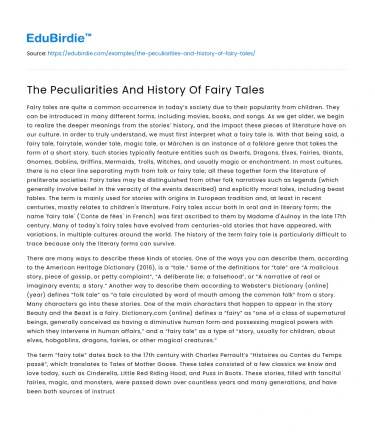Fairy tales are quite a common occurrence in today’s society due to their popularity from children. They can be introduced in many different forms, including movies, books, and songs. As we get older, we begin to realize the deeper meanings from the stories’ history, and the impact these pieces of literature have on our culture. In order to truly understand, we must first interpret what a fairy tale is. With that being said, a fairy tale, fairytale, wonder tale, magic tale, or Märchen is an instance of a folklore genre that takes the form of a short story. Such stories typically feature entities such as Dwarfs, Dragons, Elves, Fairies, Giants, Gnomes, Goblins, Griffins, Mermaids, Trolls, Witches, and usually magic or enchantment. In most cultures, there is no clear line separating myth from folk or fairy tale; all these together form the literature of preliterate societies: Fairy tales may be distinguished from other folk narratives such as legends (which generally involve belief in the veracity of the events described) and explicitly moral tales, including beast fables. The term is mainly used for stories with origins in European tradition and, at least in recent centuries, mostly relates to children's literature. Fairy tales occur both in oral and in literary form; the name 'fairy tale' ('Conte de fées' in French) was first ascribed to them by Madame d'Aulnoy in the late 17th century. Many of today's fairy tales have evolved from centuries-old stories that have appeared, with variations, in multiple cultures around the world. The history of the term fairy tale is particularly difficult to trace because only the literary forms can survive.
There are many ways to describe these kinds of stories. One of the ways you can describe them, according to the American Heritage Dictionary (2016), is a “tale.” Some of the definitions for “tale” are “A malicious story, piece of gossip, or petty complaint”, “A deliberate lie; a falsehood”, or “A narrative of real or imaginary events; a story.” Another way to describe them according to Webster’s Dictionary (online) (year) defines “folk tale” as “a tale circulated by word of mouth among the common folk” from a story. Many characters go into these stories. One of the main characters that happen to appear in the story Beauty and the Beast is a fairy. Dictionary.com (online) defines a “fairy” as “one of a class of supernatural beings, generally conceived as having a diminutive human form and possessing magical powers with which they intervene in human affairs,” and a “fairy tale” as a type of “story, usually for children, about elves, hobgoblins, dragons, fairies, or other magical creatures.”
Save your time!
We can take care of your essay
- Proper editing and formatting
- Free revision, title page, and bibliography
- Flexible prices and money-back guarantee
The term “fairy tale” dates back to the 17th century with Charles Perrault’s “Histoires ou Contes du Temps passé”, which translates to Tales of Mother Goose. These tales consisted of a few classics we know and love today, such as Cinderella, Little Red Riding Hood, and Puss in Boots. These stories, filled with fanciful fairies, magic, and monsters, were passed down over countless years and many generations, and have been both sources of instruction as well as words of caution. In fairy tales we often see a repeated theme -- a character will experience pain, suffering or confusion then have a eureka moment in order to miraculously, and against all odds, come out on top.
Fairy tales we know today are not the same as their original version. The original versions of fairy tales are most often gruesome and inappropriate, implying they were intended for adults. However, in the 19th and 20th centuries, the stories were revised to be introduced as children’s literature. The first to begin the change were the Brothers Grimm in 1812. They didn’t create the tales they wrote but instead collected the stories from different people around Europe to merge all different stories into one single copy. The versions they made of the fairy tales were not intended for children until they rewrote the stories to be fit for kids.






 Stuck on your essay?
Stuck on your essay?

